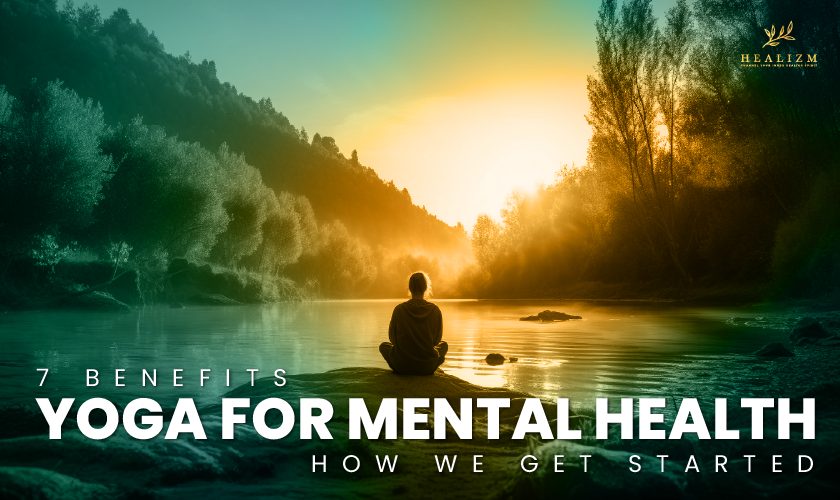Benefits of Yoga for Mental Health and How to Get Started
Yoga brings you inner balance and well-being that can transform your mind, body, and soul.
Imagine a life where stress and anxiety are replaced with a sense of calm and clarity.
Where your emotions are in harmony, and your focus is razor-sharp. Think of yourself enjoying restful sleep and waking up with renewed energy and a positive outlook.
This is the potential that yoga holds for your mental health.
In this blog post, we’ll guide you through practical tips to start your yoga journey and share insights on creating a sacred space, finding the right resources, and listening to your body’s wisdom.
Looking for a life-changing experience that will leave you feeling centered, in control, and connected? Find out how yoga can improve your mental health and positively affect your life.
1. Reduction of stress and anxiety.
Yoga is believed to relieve stress, anxiety and even depression.
Combined with physical postures, controlled breathing, and meditation, yoga activates our relaxation response.
Having this response helps reduce stress hormone production, lower blood pressure, and help you feel calm.
2. An improved emotional state.
We can learn to observe our emotions without judgment and respond positively through yoga.
Through the combination of postures, breathwork, and mindfulness, the practice offers us a safe and nurturing space to explore and process our subconscious emotions.
We can connect with our bodies, learn more about our emotions through yoga postures, and focus on our breath.
We release stored emotions when we gently stretch and strengthen our muscles, increasing circulation and encouraging introspection.
3. Better concentration and focus.
Yoga helps sharpen your concentration and focus.
By practicing yoga, we develop mindful awareness and train our minds to stay focused.
Concentration improves our performance in various areas of life, leading to more productivity.
4. Positive effects on mood and self-esteem.
Our mood and self-esteem can be lifted by yoga.
Yoga releases endorphins, also known as “feel-good” hormones, which create a feeling of happiness and euphoria.
As well as supporting a positive body image and improving self-confidence, yoga encourages self-acceptance and self-care.
5. Improved quality of sleep.
Over 55% of people who practice yoga report getting better sleep.
As a natural sleep aid, yoga promotes relaxation and stress reduction.
Several yoga poses, such as forward bend and gentle inversions, can help calm the nervous system, relieve tension, and prepare the body for deep, restorative sleep.
You can improve your sleep quality and wake up refreshed by doing yoga before bedtime.
6. A state of mindfulness and inner peace.
Yoga philosophy focuses on mindfulness, which involves paying attention to the present moment without judging it.
Yoga creates a space for self-reflection and introspection.
We develop a heightened awareness and presence by focusing on the breath and observing bodily sensations during this practice.
7. Strengthened social connections.
Even though yoga is often perceived as a solitary practice, it can also be a wonderful way to connect with others and build meaningful relationships.
In yoga classes and group sessions, you meet new people and get to know one another.
Yoga creates a supportive environment and helps you connect with yourself and others.
Teamwork and trust are further strengthened when you do yoga with a partner or in a group; there are also yoga poses for three people.
Types of Yoga
Each type of yoga has its focus, intensity, and style. Here are some of the most common types of yoga:
- Hatha yoga. Hatha yoga combines physical postures (asanas) and breathing techniques (pranayama) – it’s gentle and perfect for beginners and focuses on mind-body balance.
- Vinyasa yoga. A Vinyasa yoga class synchronizes movement with breath. It involves transitioning smoothly between poses in a continuous sequence. You’ll build strength, flexibility, and endurance with vinyasa yoga.
- Ashtanga yoga. It’s a vigorous style of yoga that follows a specific pose sequence. There’s a dynamic flow and synchronized breathing. It encourages strength, flexibility, and focus.
- Bikram yoga. Bikram yoga, or hot yoga, is performed in a heated room – usually consisting of 26 poses and two breathing exercises. The heat helps warm muscles, allowing them to stretch and detoxify.
- Iyengar Yoga. Iyengar yoga focuses on alignment and precision in each pose. Props like blocks, straps, and blankets are often used to achieve proper alignment.
- Kundalini yoga. Kundalini yoga combines dynamic movements, breathing techniques, chanting, and meditation. The objective is to awaken the dormant spiritual energy (kundalini) within the body, leading to self-awareness and inner transformation.
- Yin yoga. Yin yoga involves holding a pose for a long time, usually three to five minutes. It focuses on the deep connective tissues, providing flexibility and releasing tension.
- Restorative yoga. Restorative yoga is all about deep relaxation and rejuvenation. It involves gentle and supported poses using props, allowing the body to relax and restore fully.
If you want to incorporate a yoga couch setup into your practice, you can explore restorative yoga classes or seek guidance from a qualified yoga instructor.
Getting Started with Yoga
Now that we’ve explored the benefits of yoga for mental health let’s talk about how to get started.
You can incorporate yoga into your daily routine with these tips:
Find a yoga style that resonates with you.
Each style of yoga has its focus and intensity.
You can try out different styles, such as Hatha, Vinyasa, or Yin, to find one that works for you.
Take beginner-friendly classes.
Start with beginner-friendly classes or videos if you’re new to yoga.
You’ll learn the fundamental postures and breathing techniques from them.
Keep your goals realistic.
Initially, do shorter sessions, like 15-20 minutes, and gradually increase the duration.
Regular practice is better than long sessions sporadically, so aim for consistency.
Make your space sacred.
Designate a space in your home for yoga.
Get rid of the clutter, decorate it with soothing things, and make it a place to escape the outside world.
Make use of online resources.
Many online resources, such as yoga tutorials, guided meditations, and virtual classes, are available.
You can find resources on credible websites, YouTube channels, and yoga apps.
Always listen to your body.
Yoga is a personal practice, so listen to your body.
Be mindful of your limitations and adjust the poses if you’re uncomfortable.
If a posture feels painful or unsafe, don’t force it.
Get guidance from a qualified yoga instructor.
Join a yoga class led by a qualified instructor if you can.
You can get guidance, correct your alignment, and make changes based on your needs.
It’s safe and effective to practice with a skilled instructor.
Conclusion
Yoga is a transformative practice that taps into our natural tendency to concentrate and helps us cultivate a good mind.
As we learn more about yoga, we discover its holistic benefits – It allows us to connect with our bodies, minds, and spirits on a deeper level.
Get started on your yoga journey today.
Frequently Asked Questions
Can yoga help reduce anxiety and stress levels effectively?
Yes, yoga can be highly effective in reducing anxiety and stress levels. Its combination of physical postures, controlled breathing, and mindfulness techniques can help calm the mind and promote relaxation.
What is the difference between yoga and other forms of exercise for mental health?
The difference between yoga and other forms of exercise for mental health is the mind-body connection. Yoga places a strong focus on the integration of physical postures with breath and mindfulness, and offers a holistic approach to mental health that goes beyond just physical fitness.
Is it necessary to attend a yoga class, or can I practice at home for mental health benefits?
You can practice yoga for mental health benefits both in a class and at home. Attending a class can provide structure, guidance, and a sense of community, while practicing at home offers flexibility and convenience. Choose the approach that best suits your preferences and lifestyle.


No comment